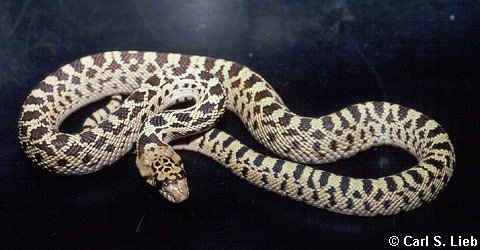What's long and thin, crawls on its belly, eats mice, and makes a rattling noise if you get too close? A rattlesnake? Maybe, but not this time! You've just been fooled by the gentle and harmless gopher snake.
But wait a minute—how can it produce a rattling sound if it doesn't have rattles on its tail? Nature is full of surprises, and gopher snakes know that merely vibrating a tail against dry vegetation can produce a sound that scares off threatening animals! Their pattern also might be mistaken for that of a rattlesnake, convincing the viewer that it's a real danger!
Unfortunately, this strategy sometimes backfires with humans. Many
people hate and fear snakes, and convincing a person that you're a rattlesnake
might be enough to make those people kill you, instead of retreating, as most animals
would. There are real rattlesnakes out there, but there's also a good chance
you've really found a fake—one doing us a real service by keeping down the
rodent population. It's better to just back off and let it live its life as nature
intended. 
Contributor: Kodi R. Jeffery, Centennial Museum, University of Texas at El Paso.
Desert Diary is a joint production of the Centennial Museum and KTEP National Public Radio at the University of Texas at El Paso.

Gopher snake (Pituophis catenifer). Photograph by Carl S. Lieb.
Degenhardt, W. G., C. W. Painter, and A. H. Price. 1996. Amphibians and reptiles of New Mexico. University of New Mexico Press, Albuquerque, 431 pp.
Centennial Museum's Chihuahuan Desert pages.